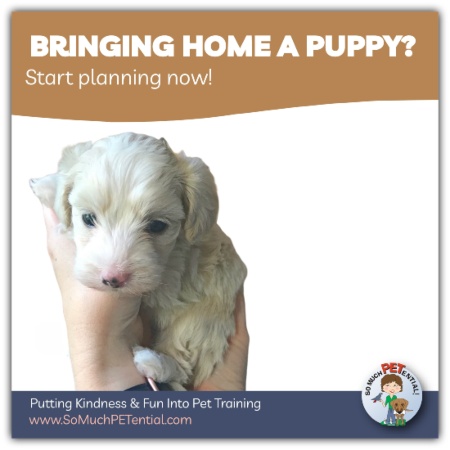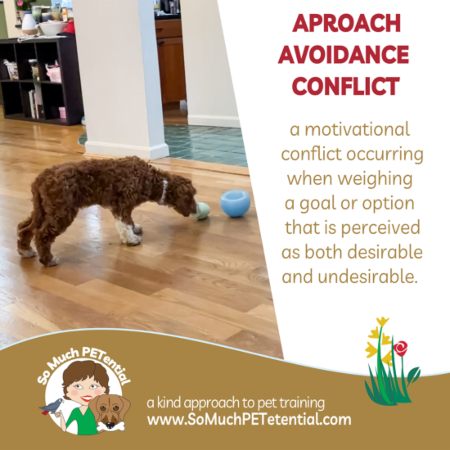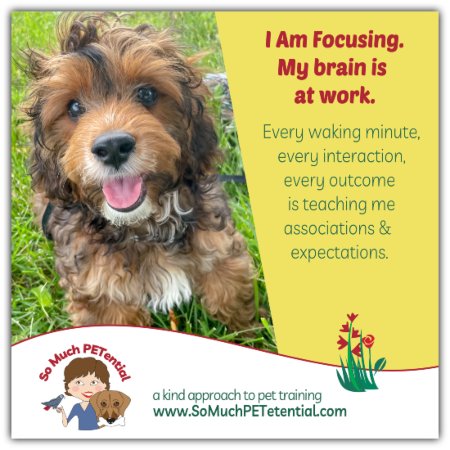Are you bringing home a puppy? Preparing for a new puppy before its arrival can go a long way toward helping you with puppy training success. While every puppy and every home is unique, I’m sharing some general tips for getting you started on the right path. At the bottom of this post, you’ll see my interview on WCPO’s Cincy Lifestyle program about getting a new puppy.
Preparing For New Puppy
Puppy Proof Your Home
This is important. You would not put a newly mobile infant on the floor of a room with all kinds of things that are either dangerous or breakable, or both. Human infants and puppies have that explorer trait in common. Your new little furry friend will be curious and adventurous. He will use his mouth and his paws to learn about his environment, and get his mental and physical stimulation needs met. And, as a young animal that is teething, he will need to chew. If you allow your puppy access, he will have no problem finding many opportunities to fulfill his wants.
The better you are at removing access to those things that could potentially hurt your puppy or could encourage practice of unwanted behaviors, the better. This includes indoor and outdoor. It is a lot easier to manage during those first months to prevent practice than it is to undo learning later.
It may be helpful to have several sets of eyes looking through your home, or even getting down on the ground to see things from the perspective of your puppy.
Get Your Puppy Supplies
You will need a variety of supplies and toys for your puppy. Once your puppy is with you, you may not have time those first few days to run out to the store to stock up. If you have time to do that before your new arrival, you will be grateful.
Here is a list of some puppy supplies to help get you started.
A baby monitoring camera (this can be super valuable as you are teaching your puppy to settle in a crate or confinement space)
Snuggle puppy heartbeat stuffed toy
Crate
Exercise Pen
Baby gates
A variety of chews such as nylabones or frozen food stuffed toys
A variety of other toys including ones that are hard, soft, for tugging, for tossing around
Food dispensing and food filling toys
6 ft leash and 15 ft leash
Standard flat collar with tags and a harness (tiny puppies may need a cat harness)
Dog treats
Dog bed
Water and food bowls
Grooming tools
Tearless puppy shampoo
Educate Yourself On Your Dog Breed (s)
Whether you will be getting a mixed or full breed, it will be helpful to learn about that breed standard. Know that every puppy is very much an individual. Just as I am very different from my sister, puppies within the same litter can vary greatly in temperament. That being said, it is helpful to understand the general needs and characteristics of the breed (s) you will be getting. (Now is the time to make sure your puppy’s needs will fit your lifestyle. If, for example, you are wanting a dog to need less exercise, a sporting or working breed likely may not be the best fit.)
Additionally, educate your children about living with a dog. Here is a blog post with some books for kids about dogs. Volunteering is also a way to encourage kids to appreciate animals. If you are in Cincinnati, consider bringing you child (age 6+) to one of my My Dog, My Best Buddy classes. I also offer this online.
Make A Game Plan.
You are about to bring home a little toddler (a puppy) to a place completely foreign to him. There is a lot to think about and plan to help make that transition easier on all of you. I love it when people schedule a Welcome Home Planning appointment with me ahead of the big day to talk through these preparations. If you are interested, please reach out for an in-person or virtual appointment.
If your home is temporarily a stressful place – either due to excessive noise, houseguests, lots of bustle and pressure, more time away than usual – consider asking if you can wait to bring home your puppy. Your young puppy will be sensitive and that additional stress can negatively impact your already stressed little friend. A hectic, strange environment can be that much more scarier during a very important transition.
When you first get your puppy home, it’s ideal to have a good chunk of time off work to spend with him/her while he/she adjusts. For the Welcome Home Day, ideally it will be great if someone can go with you to bring home your puppy. Bring a blanket, water bowl, wipes and snuggle toy. If you are getting your puppy from a breeder or a foster parent, you can ask to have those things rubbed on the puppy’s mother before getting into your car. Your puppy can lay on the lap of your passenger for the ride home.
Have you chosen a vet? Now is a great time to do that. Plan on bringing some tasty treats with you when you visit.
Gather everyone together to talk in advance of responsibilities and schedule for those first few days and beyond. Who will be feeding your puppy and taking your puppy outside? Young puppies will need to go outside often as their bladders cannot ‘hold it’. If you have children, think about what activities are and are not appropriate for them to do with and/or around your puppy. (Please reach out if I can be of help with this.) Have management planned out in advance to prevent practice of your puppy or your kids doing anything to scare or hurt the other. How will you be actively supervising your puppy in your home, and with kids and other people?
Additionally, have a discussion of what ‘house rules’ you will want to establish. As examples: Will you be allowing your puppy on furniture? Is it ok to give your puppy scraps while you are eating a meal? Where will your puppy’s potty spot be? When your puppy is so new to your family, it is an excellent time to keep these things in mind to prevent your puppy from practicing and teaching your puppy to value behaviors that you do want to see.
Those first few days are about helping your puppy to feel safe and build resilience in the new home. This is an important time to minimize stress. Spend time exploring areas of your home with your puppy. Engage in gentle playtime (not overwhelming your puppy), allowing him/her get to know your scent and familiarize that scent with good things. Introduce your puppy to one family member at a time. Wait a few days to introduce your puppy to new people and dogs. Remember too that the combination of his/her age and the stress of the day will mean he/she will need numerous naps during the day.
Remember, your young puppy will not have bladder control so you will want to take your puppy out frequently to a spot to practice pottying outside.
If you already have an adult dog in your home, do not feel pressured to hurry their introduction. This is going to be all new to both your current dog and your new puppy. Always set things up so that engaging with one another is an optional choice, carefully monitoring for body language. Give your puppy lots of activity and enrichment. Make sure to also be your older dog’s advocate. It is often helpful to have a gate separating them during this adjustment period. Read about how one of my clients handled this time with their dogs here.
I like to begin right away conditioning a puppy to feel comfortable and safe in a crate, and see the crate as a nice place to rest and sleep. You will thank yourself for this later. To do this, do not force your puppy into a closed crate. Being home those first few days, you can spend time working on this. I wrote a blog post on how I worked with my maltipoo, Dawson, on this during his first weekend with me. You can read it here.
That first night may be scary for your puppy. It more than likely will be his first night away from his littermates. Having your puppy sleep overnight in a crate near your bed, with a snuggle heartbeat stuffed animal, can help your puppy to feel more secure.
During the night, it is common for young puppies to get restless, then whine and bark when they need to potty. Take your puppy quietly outside to potty, and then bring him/her back quietly to go back to sleep.
Additionally, engaging your puppy in mental and/or sniffing activities (but not TOO energizing), followed by quieter time to decompress and then moving into a darkened, quiet room for sleep can help.
Other helpful articles:
How I crate trained my Dawson.
Introducing puppy to resident dog
Why practice good management between your puppy and resident dog
Getting your puppy to sleep through the night









